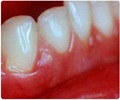
‘A gel treats gum disease by suppressing inflammation and changing the bacteria makeup in the mouth by blocking a substance involved in metabolism.’
Tweet it Now
Advertisement
Which is the Best Treatment for Gum Disease?
Gum disease (also known as periodontitis or periodontal disease) is one of the most prevalent inflammatory diseases, affecting nearly half of adults 30 and older. It is marked by three components: inflammation, an imbalance of unhealthy and healthy bacteria in the mouth, and destruction of the bones and structures that support the teeth. Uncontrolled gum disease can lead to painful and bleeding gums, difficulty chewing, and tooth loss.No current treatment for gum disease simultaneously reduces inflammation, limits disruption to the oral microbiome, and prevents bone loss. There is an urgent public health need for more targeted and effective treatments for this common disease.
Past research has linked increased succinate (a molecule produced during metabolism) to gum disease, with higher succinate levels associated with higher levels of inflammation.
Researchers at NYU Dentistry also discovered in 2017 that elevated levels of succinate activate the succinate receptor and stimulate bone loss. These findings made the succinate receptor an appealing target for countering inflammation and bone loss and potentially stopping gum disease in its tracks.
Advertisement
Link Between Succinate and Gum Disease
Later, they started to examine dental plaque samples from humans and blood samples from mice. Using metabolomic analyses, they found higher succinate levels in people and mice with gum disease compared to those with healthy gums, confirming what previous studies have found.They also saw that the succinate receptor was expressed in human and mouse gums. To test the connection between the succinate receptor and the components of gum disease, they genetically altered mice to inactivate, or “knock out,” the succinate receptor.
In “knockout” mice with gum disease, the researchers measured lower levels of inflammation in both the gum tissue and blood, as well as less bone loss. They also found different bacteria in their mouths: mice with gum disease had a greater imbalance of bacteria than did “knockout” mice.
While we already knew that there was some connection between succinate and gum disease, now we have stronger evidence that elevated succinate and the succinate receptor are major drivers of the disease.
Advertisement
Topical Gel: A Novel Treatment In Gum Disease
To see if blocking the succinate receptor could ameliorate gum disease, the researchers developed a gel formulation of a small compound that targets the succinate receptor and prevents it from being activated. In laboratory studies of human gum cells, the compound reduced inflammation and processes that lead to bone loss.The compound was then applied as a topical gel to the gums of mice with gum disease, which reduced local and systemic inflammation and bone loss in a matter of days.
Mice treated with the gel also had significant changes in the community of bacteria in their mouths. Notably, bacteria in the Bacteroidetes family—which include pathogens that are known to be dominant in gum disease—were depleted in those treated with the gel.
Researchers are continuing to study the gel in animal models to find the appropriate dosage and timing for application, as well as determine any toxicity. Their long-term goal is to develop a gel and oral strip that can be used at home by people with or at risk for gum disease, as well as a stronger, slow-release formulation that dentists can apply to pockets that form in the gums during gum disease.
Source-Medindia















